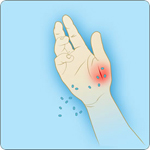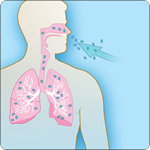DHHS → MeCDC → Disease Surveillance → Epidemiology → Airborne and Direct Contact Diseases → Anthrax
Anthrax 
On this page:
About Anthrax
Anthrax is a disease caused by the bacteria called Bacillus anthracis. It occurs naturally in soil around the world. It can infect people, domestic animals, and wild animals.
How do people get infected with Anthrax?
People get infected when they:
- Breathe in the bacteria
- Have contact with infected animals
- Eat food or drink water contaminated with the bacteria
- Get the bacteria in a cut or scrape in the skin
Anthrax can live for years in the environment in tiny shells, called spores. When the spores get into the body of a person or animal, the spores get "activated". Now the bacteria can multiply, spread through the body, and cause disease.
Anthrax is NOT contagious from person to person. You cannot catch anthrax from another person like you might catch a cold, COVID-19, or the flu.

Anthrax and terrorism
In the U.S., anthrax is on the list of the most likely germs for a biological attack. A biological attack, or bioterrorism, is the intentional release of a germ. This could be viruses, bacteria, or other germs that can make people, livestock, or crops sick or kill them.
Anthrax makes a good weapon because the tiny spores are easy to put into powders, sprays, food, or water. In 2001, some people in the U.S. got anthrax from handling mail with spores in it.
Symptoms
Symptoms of anthrax can show up 1 day to more than 2 months after infection. Symptoms of anthrax depend on how a person becomes infected. If untreated, anthrax can spready throughout the body and cause severe illness or death. Common symptoms include:

Fever and chills

Nausea and vomiting

Abdominal pain

Headache

Cutaneous (skin) anthrax: People who get infected through a scrape or cut in the skin get cutaneous (skin) anthrax. These people can get small, itchy blisters that turn into a painless skin sore with a black center.

Inhalation anthrax: People who get infected by breathing in the anthrax spores get inhalation anthrax. These people can have:
- Chest discomfort
- Shortness of breath
- Confusion or dizziness
- Cough
- Sweats (often drenching)
- Body aches
- Extreme tiredness

Gastrointestinal anthrax: People who get infected by eating contaminated food or drinking contaminated water get gastroinstestinal anthrax. These people can have:
- Sore throat
- Hoarse or scratchy voice
- Diarrhea (sometimes bloody)
- Swelling of the abdomen
What should I do if I think I have anthrax?
Talk to a health care provider right away if:
- You think you have anthrax symptoms
- You think you were exposed to anthrax but don't have symptoms yet
Who is at risk?
Most people in the U.S. will never get exposed to anthrax. Some activities can put people at greater risk of exposure. These include:

Working in a laboratory that works with anthrax

Working with animals or handling animal products

Handling mail

Being a member of the military or response personnel

Traveling
Prevention
If you travel to an area where anthrax is common:
- Avoid contact with livestock, animal products, and animal carcasses.
- Do not eat raw or undercooked meat.
Take special care when handling animal products. People can develop anthrax after contact with products from infected animals. This includes wool, hides, and hair.
- Use caution when buying animal hide drums. People in the U.S. have gotten anthrax from imported animal hides used to make drums.
- If using animal hides, make sure they are processed in a way that reduces the risk of getting anthrax.
- U.S. CDC recommends using animal products that come from the U.S. If using imported animal hides, make sure they have an international veterinary certificate. This shows that the products have been inspected to reduce risk.
A vaccine is available for anthrax for certain at-risk groups. This includes laboratory workers who work with anthrax, certain people who handle high risk animals or animal products, and members of the military.

Icons from www.flaticon.com. Images from U.S. CDC.



